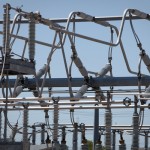Not Enough: Even Higher Price for Electricity Urged for Texas

Dave Fehling/StateImpact Texas
NRG's Cedar Bayou power plant expanded in 2009: "We could not do that today"
According to some industry insiders, when the state-regulated peak price for wholesale electricity jumps 50% next month, it will fail to do what the Texas Public Utility Commission (PUC) had hoped: encourage the construction of new power plants to avert shortages.
“The prices have to go up before you see any significant generation being built,” said Dallas energy consultant John Bick, formerly with TXU Energy, now with Priority Power Management.
The Critical Hours for Making Money
Last month, the PUC approved raising the cap on the peak-demand price from $3,000 per megawatt hour to $4,500/MWh starting August 1. That’s not high enough?
“Correct”, says Bick.
How about $6,000, even $9,000? Would that have an effect?
“I agree, yes,” says Bick.

Dave Fehling/StateImpact Texas
John Ragan inside NRG's Houston operations center
Also agreeing that a much higher peak price is needed is John Ragan, president of NRG’s Gulf Coast operations, the second biggest power generator in Texas (Dallas-based Luminant is number one).
“You have to understand that electric generators in the market we have in Texas really earn their return on those very high-priced hours. And there’s only a couple hundred of those hours in any given year,” Ragan told StateImpact in an interview at NRG’s Houston office.
“The rest of the time, the prices are $30, $20 (a megawatt hour), at night they go negative. So these hours are critical. But we do need to see a very high price for those hours to make economic sense for development of new generation,” said Ragan.
He said they call that critical margin—usually earned during extreme weather— the “missing money” that would make it possible to invest in new power plants.

Dave Fehling/StateImpact Texas
Power lines cross Cedar Bayou in Chambers County
Power Down on the Bayou
The last time NRG said it could justify a new plant wasn’t that long ago. In 2009, the company fired-up a new, natural gas-burning power plant called Cedar Bayou Unit 4, located near Galveston Bay in Chambers County. Medium-sized plants like it can cost a half billion dollars.
“Our shareholders took the risk of that. We provided equity to build that plant. We did that when (natural) gas prices were much higher which meant power prices were much higher. And therefore, at the time, it made economic sense to do so.”
NRG couldn’t do that today?
“We could not do that today,” said Ragan. “It doesn’t make sense for us to make that kind of investment.”
The PUC has indicated it’s willing to consider hiking the peak price to as high as $9,000/MWh. Though a study done for the PUC found that even at that price, development of new power plants would still fall short of the state’s goal for reserves to avoid blackouts.
Raise the Price But Will They Build
Some projects are in the works. Panda Energy is planning a new gas-fired power plant in Temple that could provide electricity to 900,000 homes. While acknowledging the risks of the Texas wholesale power market, Standard and Poor’s—the credit rating company—said it expects Texas to have less and less reserves in the next five years, a good sign it said for the Panda project.
“If this trend holds, there could be considerable support for higher prices, which in turn would likely promote development of new power plants,” S&P said in a report.
But some critics have doubts that no matter the higher peak price, few new plants will get built. The Texas chapter of the Sierra Club has asserted that the only sure thing is that big energy companies will rake in far higher profits. The group’s “Beyond Coal” campaign advocates conservation and alternative energy.
Advocates for electricity users, both residential and commercial, warn it’ll mean higher utility bills. The Texas Industrial Energy Consumers group said if the price cap were increased to $9,000/MWh, it would add $14 billion a year to Texas wholesale electricity costs which could translate into hundreds of dollars a year for residential customers.
NRG’s John Ragan disagrees.
“In general, industrial and residential customers will not be that impacted by what sounds like very high prices,” Ragan said.

